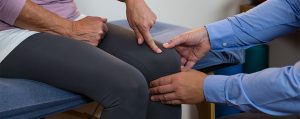What Is Vestibular Therapy?
Posted on by Peter Batz, PT, DPT, OCS, CMTPT, AIB-VRC
Vestibular Physical Therapy or Vestibular Rehab Therapy (VRT) is an exercise-based treatment program which is designed to decrease symptoms of dizziness, spinning or loss of balance. The word “vestibular” refers to a connection between the ears and the brain which assists with balance while doing things throughout the day.
(more…)
What Does Home Therapy Look Like?
Posted on by Andrew Cassidy, PT, DPT
Physical therapy plays a crucial role in regaining mobility and improving quality of life when recovering from an injury or managing a chronic condition. However, traveling to an outpatient clinic can be a significant hurdle for some patients. Athletico Physical Therapy offers a solution through its comprehensive home therapy services, designed to bring professional care directly to your doorstep.
(more…)
Preventing Sprain, Strains, OSHA Recordables, and Medical Spend with Rural, Remote, and Distributed Workforces
Posted on by Geoff Wolfe, CEAS III, CFSC
If you’re involved in safety, work in a physically demanding industry, have a rural, remote, or geographically distributed workforce, and routinely sigh at how local providers manage minor injuries – this one is for you.
You know the same things we do - sprains and strains make up about 40% of injuries and lead to a litany of unnecessary healthcare, administrative, and operational costs, not to mention OSHA Recordables, lost time, etc. Our goal is to help employers change their destiny by shifting their approach to the prevention and management of ever-present minor aches and pains, such as low back pain and sore shoulders and necks. We use many of the same tools; we just use them in a way that most don’t (or won’t).
(more…)
Training Guide For Long Distance Runners: Tips For A Successful Race Day
Posted on by Rebecca Pudvah PT, DPT, CSCS, OCS
You have spent hours planning, training, laundering your workout clothes, and organizing your schedule to ensure you are trained, hydrated, well-fed, ready, and rested for your upcoming event. Below are some tips to help you prepare for a successful race day.
(more…)
Tips for Hiking with Knee Arthritis
Posted on by Andrew Cassidy, PT, DPT
Heading out for a hike can challenge individuals with knee arthritis. The sharp or aching pain you experience can slow down or even prevent you from hitting the trails. However, with the right guidance and strategies, you can still be an active hiker despite knee arthritis. In this blog post, we’ll review insights and recommendations from a physical therapist's perspective to help hikers manage knee arthritis and continue exploring the outdoors safely and comfortably.
(more…)
3 Patient Success Stories Who Tried Vestibular Therapy And Got Their Balance Back
Posted on by Kimberly Smith, PT, DPT, VRT
Vestibular Therapy is more than just helping you avoid injuries from falls. Our therapists help you manage your symptoms, teach you strategies and techniques to feel safe, as well as validate your entire experience. Our therapists are trained to provide a safe space to navigate your “invisible” condition. Our sessions are meant to help you feel heard, educate you on what to expect on your journey, and how to manage the good and not-so-good days.
(more…)
Dry Needling For Jaw Pain And TMD
Posted on by Tara Hackney, PT, DPT, OCS, KTTP
The temporomandibular joint (TMJ) is the joint where your jaw attaches to the temple of the skull. It is a joint that allows you to move your jaw up and down and side to side. This joint is essential for guiding movements required for chewing, swallowing, and speaking. Temporomandibular joint disorders (TMD) are conditions associated with dysfunction of the joint as well as the associated muscles.
The cause of TMD is still widely unknown. However, the majority of patients with TMD suffer from malpositioning of the TMJ disc, and muscle tightness in the jaw, face, and neck. TMD can present differently in every individual, so a clinical examination is recommended to customize a plan of care. One option for treating TMD is dry needling.
(more…)
Can Physical Therapy Help A Pinched Nerve?
Posted on by Erik Krol, MOT, OTR/L
A compressed nerve, otherwise commonly called a pinched nerve, can be debilitating and, at the very least, frustrating. Knowing the root cause of the nerve injury, whether it be from an internal cause like scar tissue or an external cause like crutches/or hard surfaces, can help create a plan of action and care.
(more…)
